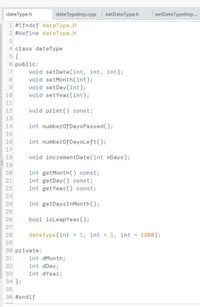
The class dateType defined in Programming Exercise 6 prints the date in numerical form. Some applications might require the date to be printed in another form, such as March 24, 2019. Derive the class extDateType so that the date can be printed in either form.
Add a member variable to the class extDateType so that the month can also be stored in string form. Add a member function to output the month in the string format, followed by the year—for example, in the form March 2019.
Write the definitions of the functions to implement the operations for the class extDateType.
Note: you may write a main.cpp to test your class but will not be graded on the main.cpp.
I am missing extDateTypeImp.cpp, that is what I need help with. The images attached are the codes that I Have been provided already. PLEASE help with extDateTypeImp.cpp.
This is what cengage mindTap is checking for: Correct long date is output
![dateType.h
dateTypelmp.cpp
extDateType.h
extDateTypelmp.
2 #ifndef extDateType_H
3 #define extDateType_H
4
5 #include <string>
7 #include "dateType.h"
8
9 using namespace std;
10
11 string months[] = {"January", "February", "March",
"April",
12
"May", "June", "July", "August",
13
"December"};
"September", "October", "November",
14
15 class extDateType: public dateType
16 {
17 public:
void printLongDate();
void setDate(int, int, int);
void setMonth(int m);
18
19
20
21
22
void printLongMonthYear ();
23
24
extDateType();
extDateType(int, int, int);
25
26
27 private:
28
29 };
30
string month;
31 #endif
32](https://content.bartleby.com/qna-images/question/b7f69a15-0916-4ce9-9c0b-3bf552a1a604/6f129b63-b782-49db-bd3f-aca2e70fa9c5/plgdm8_thumbnail.jpeg)

Trending nowThis is a popular solution!
Step by stepSolved in 5 steps with 4 images

- Which statement of the following is the most appropriate? Group of answer choices When you design a class, always make an explicit statement of the rules that dictate how the member variables are used. These rules are called the invariant of the class, and should be written at the botttom of the implementation file for easy reference. When you design a class, always make an explicit statement of the rules that dictate how the member variables are used. These rules are called the variant of the class, and should be written at the botttom of the implementation file for easy reference. When you design a class, always make an explicit statement of the rules that dictate how the member variables are used. These rules are called the invariant of the class, and should be written at the top of the implementation file for easy reference. When you design a class, always make an explicit statement of the rules that dictate how the member variables are used. These rules are called the…arrow_forwardC- Create the sub class UsedBook that is derived from the super class Book and has the following instance variables, constructor, and functions: title ( String) isbn ( String) authors (String) publisher (String) edition ( int) published_year (int) price_new (double) // the price of the book if it is new age (int) // how old the book is in years Constructor that takes all of the above variables as input parameters. set/get functions calculate_price method // the price is calculated as price_new * (1- 0.10*age) print function that prints all information related to the old book. D- Create the Testing class that has the main method and does the following: aa- Use the constructor to create instance of NewBook class and name it as new. Call compute_price function. bb- Use the constructor to create instance of usedBook class and name it used. Call compute_price function. cc- Print the related information of new and used objects using print functions. Use this following code: class…arrow_forwardRewrite the calculator program using a class called calculator. Your program will keep asking the user if they want to perform more calculations or quit and will have a function displayMenu to display the different functions e.g .(1 - addition, 2- subtraction, 3- multiplication, 4- division) Your program must have appropriate constructors and member functions to initialize, access, and manipulate the data members as well as : A member function to perform the addition and return the result A member function to perform the subtraction and return the result A member function to perform the multiplication and return the result A member function to perform the division and return the resultarrow_forward
 Database System ConceptsComputer ScienceISBN:9780078022159Author:Abraham Silberschatz Professor, Henry F. Korth, S. SudarshanPublisher:McGraw-Hill Education
Database System ConceptsComputer ScienceISBN:9780078022159Author:Abraham Silberschatz Professor, Henry F. Korth, S. SudarshanPublisher:McGraw-Hill Education Starting Out with Python (4th Edition)Computer ScienceISBN:9780134444321Author:Tony GaddisPublisher:PEARSON
Starting Out with Python (4th Edition)Computer ScienceISBN:9780134444321Author:Tony GaddisPublisher:PEARSON Digital Fundamentals (11th Edition)Computer ScienceISBN:9780132737968Author:Thomas L. FloydPublisher:PEARSON
Digital Fundamentals (11th Edition)Computer ScienceISBN:9780132737968Author:Thomas L. FloydPublisher:PEARSON C How to Program (8th Edition)Computer ScienceISBN:9780133976892Author:Paul J. Deitel, Harvey DeitelPublisher:PEARSON
C How to Program (8th Edition)Computer ScienceISBN:9780133976892Author:Paul J. Deitel, Harvey DeitelPublisher:PEARSON Database Systems: Design, Implementation, & Manag...Computer ScienceISBN:9781337627900Author:Carlos Coronel, Steven MorrisPublisher:Cengage Learning
Database Systems: Design, Implementation, & Manag...Computer ScienceISBN:9781337627900Author:Carlos Coronel, Steven MorrisPublisher:Cengage Learning Programmable Logic ControllersComputer ScienceISBN:9780073373843Author:Frank D. PetruzellaPublisher:McGraw-Hill Education
Programmable Logic ControllersComputer ScienceISBN:9780073373843Author:Frank D. PetruzellaPublisher:McGraw-Hill Education





